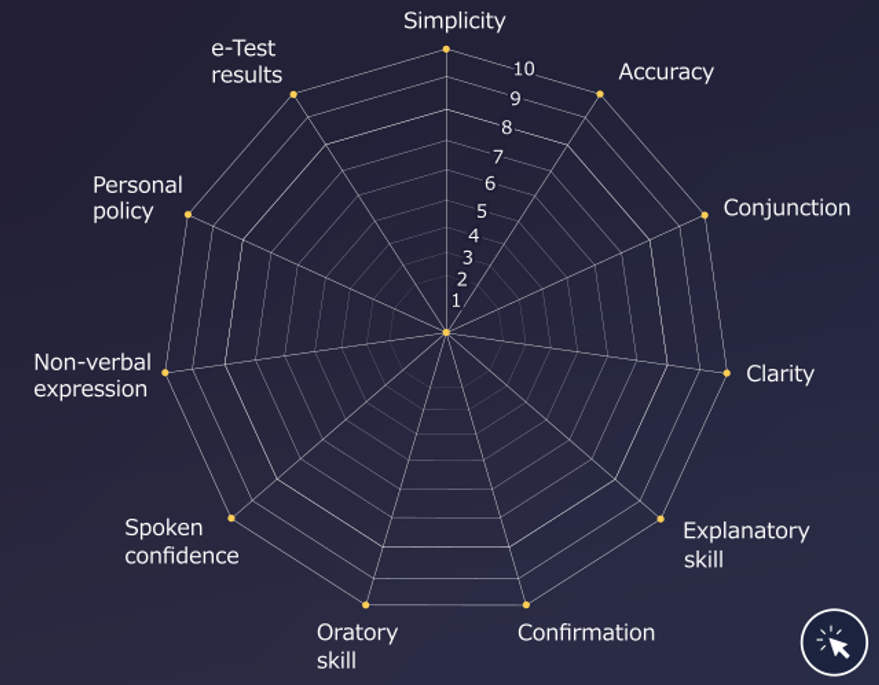TESTS & EVALUATION
Communication skills, visualised
It is a misconception that the best way to judge someone's communicative ability is through tests, and particularly multiple-choice reading and listening tests. However, test scores represent only one of many skills needed to communicate effectively. We at Parakaro have summarised the main skills needed for effective communication and turned them into an evaluation system, called the Communication Ability Evaluation (CAE).


skill
skill
confidence
expression
policy
results
In the CAE,
we evaluate students on a scale from
zero (introductory) to ten (expert) in six verbal skills,
four non-verbal skills and one test.
From these scores, we display the scores in a radar chart
and compile a communication score from 0 to 100.
Each skill has its own meaning and importance,
but some are more important in work conversation than others.
Here are two examples:



Example 1



skill
skill
confidence
expression
policy
results
Here, the scores for "accuracy", "voice control" and "e-Test score" are high, while his "spoken confidence", "confirmation" and "non-verbal communication" scores are low. This suggests that the student has a lot of knowledge of a foreign language but does not have the skills required to communicate in meetings, or face-to-face with customers. It will be diffucult for the student or their company to make money long-term with this CAE.
Here, the scores for "simplicity", "explanatory" and "spoken confidence" are high, while his "accuracy", "conjunctions" and "e-Test" scores are low. This suggests that the student may not know much grammar or many words, but he can use simple sentences to communicate clearly and in detail. These can potentially earn the student and their company money.



skill
skill
confidence
expression
policy
results
Example 2

In addition to the CAE, we provide students with
a test of their potential linguistic ability, called the
Potential Test
The Potential Test is a one-off test which measures each student's test
innate affinity towards language learning.
The higher a student's test score,
the higher the potential is for the student to reach a high level of
linguistic competency. We use this score along with the CAE to track
each student's progress throughout our courses.
このテストで登場する、新しい言葉では、「わたしはエンジニアです。」と言い方を次のように言います。つまり、「わたし」の「は」は使わず、動詞「です」は最後にこなくて、主語のすぐ後に来ます。ですから、
「わたしはエンジニアです。」は
「わたし です エンジニア」となります。
(ここからこのテストの最後にかけて、次々にルールが追加されています。一つずつルールを理解しながら進んでください。)
疑問文は主語意図同士を入れ替えます。例えば、
「彼はエンジニアですか?」は
「です 彼 エンジニア?」となります。
否定文は動詞の後に「ない」を入れます。例えば、
「彼女はアンジニアではありません。」は
「彼女 です ない エンジニア」となります。
複数になると、「たち」がつきます。ですから、「彼ら」や「これら」というような言葉でも、単純に「たち」をつけるだけで、「彼たち」や「これたち」となります。動詞の「です」は、主語が複数になると「でーす」のように「え」の音が入ります。例えば、
「わたしたちはえんじにあです。」は
「わたしたち でーす エンジニアたち」となります。
Example


